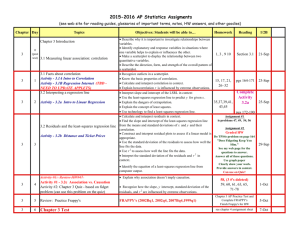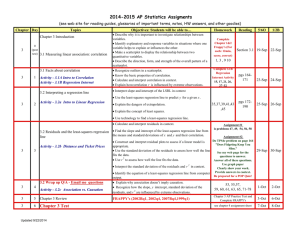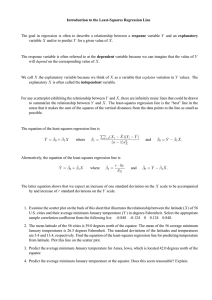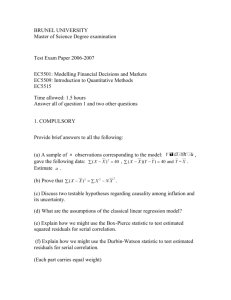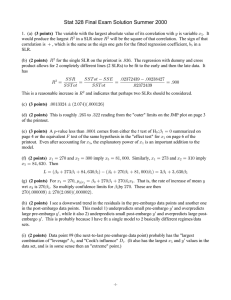STAT 515 --- STATISTICAL METHODS
advertisement
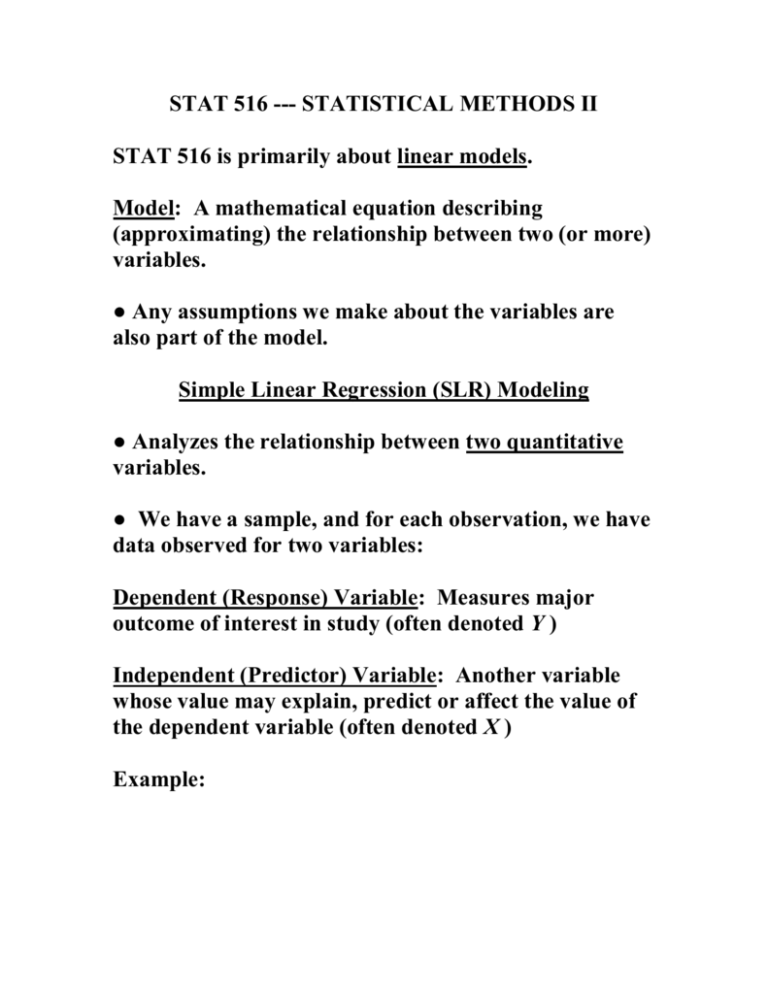
STAT 516 --- STATISTICAL METHODS II STAT 516 is primarily about linear models. Model: A mathematical equation describing (approximating) the relationship between two (or more) variables. ● Any assumptions we make about the variables are also part of the model. Simple Linear Regression (SLR) Modeling ● Analyzes the relationship between two quantitative variables. ● We have a sample, and for each observation, we have data observed for two variables: Dependent (Response) Variable: Measures major outcome of interest in study (often denoted Y ) Independent (Predictor) Variable: Another variable whose value may explain, predict or affect the value of the dependent variable (often denoted X ) Example: ● In SLR, we assume the relationship between Y and X can be mathematically approximated by a straight-line equation. ● We assume this is a statistical relationship: not a perfect linear relationship, but an approximately linear one. Example: Consider the relationship between X= Y= We might expect that gas spending changes with distance traveled – maybe nearly linearly. ● If we took a sample of trips and measured X and Y for each, would the data fall exactly along a line? Picture: ● Our goal is often to predict Y (or to estimate the mean of Y ) based on a given value of X. Examples: Simple Linear Regression Model: (expressed mathematically) Y 0 1 X Deterministic Component: Random Component: Regression Coefficients: 0 = 1 = = We assume has a Since has mean 0, the mean (expected value) of Y, for a given X-value, is: ● This is called the conditional mean of Y. ● The deterministic part of the SLR model is simply the mean of Y for any value of X: Example: Suppose 0 = 2, 1 = 1. Picture: ●When X = 1, E(Y) = ● When X = 2, E(Y) = ● The actual Y values we observe for these X values are a little different – they vary along with the random error component . Assumptions for the SLR model: ● The linear model is correctly specified ● The error terms are independent across observations ● The error terms are normally distributed ● The error terms have the same variance, 2, across observations Notes: ● Even if Y is linearly related to X, we rarely conclude that X causes Y. -- This would require eliminating all unobserved factors as possible causes for Y. ● We should not use the regression line for extrapolation: that is, predicting Y for any X values outside the range of our observed X values. -- We have no evidence that a linear relationship is appropriate outside the observed range. Picture: Example: Data gathered on 58 houses (Table 7.2, p. 328) X = size of house (in thousands of square feet) Y = selling price of house (in thousands of dollars) ● Is a linear relationship between X and Y appropriate? On computer, examine a scatter plot of the sample data. ● How to choose the “best” slope and intercept for these data? Estimating Parameters ● 0 and 1 are unknown parameters. ● We use the sample data to find estimates ̂ 0 and ˆ1 . ● Typically done by choosing ̂ and ˆ to produce the 0 least-squares regression line: Picture: 1 For each data point, predicted Y-value is denoted Yˆ . Picture: ● Residual (or error) = Y – Yˆ for each data point. ● We want our line to make these residuals as small as possible. Least-squares line: The line chosen so that the sum of squared residuals (SSE) is minimized. ● Choose ̂ 0 and ˆ1 to minimize: Example: (House Price data): The following can be calculated from the sample: So the estimates are: Our estimated regression line is: ● Typically, we calculate the least-squares estimates on the computer. Interpretations of estimated slope and intercept:


